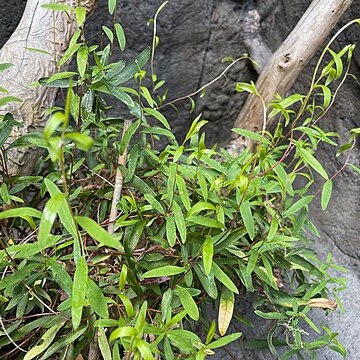Mostly a slender twiner; new shoots very slightly ridged, persisting softly hairy; older stems glabrous, red-brown. Younger developmental stage leaves with silky hairy midribs and margins, glabrescent. Adult leaves alternate, very shortly petiolate; lamina mostly narrowly elliptic to almost linear, 30–65 mm long, (3–) 6–13 mm wide, dark green, discolorous, margin thick and slightly down-turned, apex almost cuspidate; petiole (1–2 mm long). Inflorescences nearly sessile, corymbose, 10 or more almost rotate flowers; distinct rachis 6–10 mm long, peduncles less than 10 mm long; bracts and bracteoles all softly hairy, caducous. Sepals 2–3 mm long, yellow-green, noticeably unequal, green or colour matching petals, hairy on both surfaces, margins woolly. Petals 12–20 mm long, clawed, briefly cohering forming a narrow tube longer than the blade, apices reflexing, hairy. Colour changes: initially very pale blue or pale pink at anthesis, deepening with age and sex phase change, with contrasting deeper colouring spreading from the throat; never cream or yellow. Stamens free, filaments tapering to a wider base, anthers ovoid with a prominent mucro. Pistil with a wide, disc-like receptacle and basal nectary; ovary 3–4 mm long, silky hairy (subsp. cymosa) or glabrous (subsp. pseudocymosa); style can be as long as the ovary when fully extended. Fruit bilocular, berry-like with seeds in separate dry cells, slightly obovate, c. 12–15 mm long. Seeds numerous, discoidal, muricate.
More
A shrubby slender climber. It grows 1-2 m tall. The young branches and leaves have fine silky hairs. The leaves are short and slender. The flowers are 2 cm across. They are borne in clusters at the ends of branches. The colour can vary from cream to red to blue. The fruit are oblong and hang down. They are reddish berries. They are 2 cm long.
Temperate. It can grow in subtropical and semiarid regions. It grows in inland New South Wales, Victoria and South Australia. It suits drier areas. It needs well drained soils. It can grow in full sun. It can stand heavy frost.
More
Woodlands, mallees and coastal heaths, on sandy soils.
Mallee and eucalypt woodland; never common.

